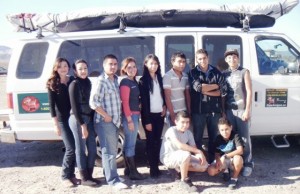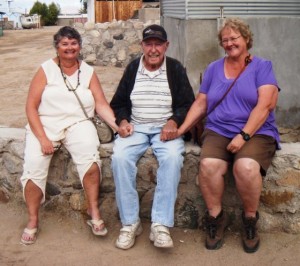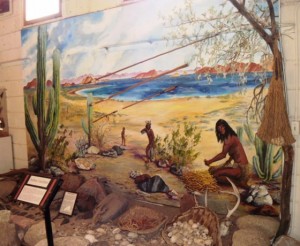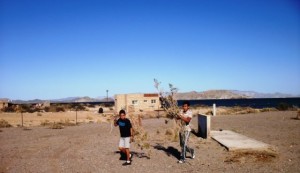
December 15, 2012 – Well this tour has almost concluded and this evening we host our farewell dinner at Cecilia’s restaurant, Baja Fiesta. The gang is looking forward to the meal and everyone has been catching up on email and showers after spending a few days without in Bahia De Los Angeles and Catavina. What a send off we had at Bahia with strong westerly winds and lots of rain the last night, nice and fresh in the morning for sure. A walkabout amongst the desert plants was scheduled at Catavina when we arrived however at 13C and blowing winds not many were interested in the hike, the same went for the fire with our propane camp chef and wiener roast we planned by the time it got dark it had dropped to 11C. Fortunately Heather & George hosted a Happy hour in their 5th wheel everyone appreciated their hospitality, comfortable chairs and heat. Thank you George & Heather!
 We are happy to report the abandoned RV Park “Brisa Marina”, which has really been languishing in disrepair for many years is now getting some TLC from the local community. The local Ejido, which owns the property, has for some time put the local school in charge of the campground for many years. In theory the school would collect the camping fees, take care of the garbage, provide receipts and deal with any campground concerns that may arise during the camping season. Unfortunately this did not occur on a regular basis and the school and students missed the opportunity to collect vital revenue in a community that really needed it. Over the years Brisa Marina has seen many RVers, both short term and long term, some arriving in November and staying until the end of March or beyond.
We are happy to report the abandoned RV Park “Brisa Marina”, which has really been languishing in disrepair for many years is now getting some TLC from the local community. The local Ejido, which owns the property, has for some time put the local school in charge of the campground for many years. In theory the school would collect the camping fees, take care of the garbage, provide receipts and deal with any campground concerns that may arise during the camping season. Unfortunately this did not occur on a regular basis and the school and students missed the opportunity to collect vital revenue in a community that really needed it. Over the years Brisa Marina has seen many RVers, both short term and long term, some arriving in November and staying until the end of March or beyond.
Bahia de Los Angeles, often referred to as LA Bay,has a well deserved reputation for excellent fishing and is an exceptionally beautiful place with stunning sunrises where marine life such as dolphins, whales and sea lions can be seen from the shore. On our first trip to Mexico, Lisa and I spent a few days here and really fell in love with Mexico, we also made our first of many contacts, Antonio Resendiz, that have lasted a lifetime.

When we arrived students from a couple of schools were actively cleaning up Brisa Marina, supervised by Tony Thompson. Tony & Ursula have called the campground home every winter for many years and have now been designated the Brisa Marina Campground Hosts. Tony & Ursula are well suited for this role as they engage in the same duties back in Canada at an RV Park in Valemont, BC. Firewood and potable water is now available for purchase, a new fence has been constructed at one end of the park with consideration for more. The general cleanup continued during our stay and we know there are discussions for removing the old derelict office structures which are quite an eyesore. This is all good news for this campground, the schools and the local community!


Only 1 day left on tour and our Baja adventure continues tomorrow with our stop in the Valley of Guadalupe and a wine tour and tastings.
What is an Ejido?
In the 1800’s the main financial promoters of independence in Mexico were a few wealthy families with large parcels of land or “Latifundios”. The Mexican Revolution (Civil War of 1910-1919) was a direct result of the efforts of these families to retain their land ownership rights. In 1920 the concept of the Ejido was adopted by Mexican President Alvaro Obregon, in the form of the “Ley de Ejidos” (Ejido Act). The government ceded land to local inhabitants, as a community, mostly of Indian origin, for use as farmland. Initiated during a period when vast areas of Mexico were sparsely populated, there was no concept of individual land ownership. The new farming community, or “Ejido” could decide whether they wanted to hold all of the land public for the use of every member of the community as a collective; or it could decide whether they wanted to permanently distribute it individually to its members.

Today, Ejidos still manage much of the collective ownership of land in Mexico that includes electing administrators who function much as a mayor and his staff do in small towns in the U.S. or Canada. In 1934, the Ejido act was made part of the constitution and has been continually amended. Prior to 1992 Ejido land was owned entirely by the Mexican government who recognized systemic problems, as Ejido members illegally leased or sold their farmland. In response, Mexican legislators in 1992 approved the “Nueva Ley Agraria”, the New Farm Act, designating individual Ejidos as legal entities. An Ejido could then represent itself by elected board members that included legal property rights.


